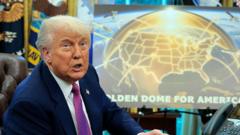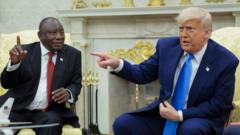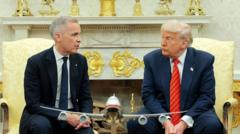The conceptual "Golden Dome," aimed at enhancing the U.S. missile defense against advanced threats, faces scrutiny over its high costs and logistical complexity. Experts are divided on its feasibility, suggesting it may be caught in a race against escalating global aggressions.
Trump’s Ambitious Golden Dome: A Future of Defense or Just a Dream?

Trump’s Ambitious Golden Dome: A Future of Defense or Just a Dream?
President Trump's proposed "Golden Dome" missile defense system is met with skepticism as its feasibility is questioned amid complex technological challenges and enormous costs.
President Donald Trump’s vision for the United States’ missile defense system, dubbed the "Golden Dome," promises to shield the nation from emerging threats like hypersonic weapons and electromagnetic pulses (EMPs) that could result from nuclear detonations. These threats underscore a pressing concern among experts regarding America’s outdated defense systems, which may be ill-equipped for modern warfare scenarios. "The catastrophic consequences of an EMP attack could regress our way of life by centuries," warns William Fortschen, a weapons researcher.
This proposed system, which Trump envisions completing by the end of his term, aims to incorporate next-generation technologies to enhance the U.S.’s defensive capabilities. The initiative has evolved from a concept first referred to as the "Iron Dome for America" and is suggested to include multi-layered defense architectures that span land, sea, and space. While these initiatives are branded necessary due to increasing global threats, experts highlight the complexities and potential budget overruns involved.
Critics argue that while there is consensus on the need for enhanced missile defense, the practicalities of the Golden Dome are daunting. Existing systems have been designed primarily for intercontinental ballistic missiles (ICBMs) from specific adversaries, while Russia and China are developing capabilities that transcend these traditional threats. Patrycja Bazylczyk, a missile defense expert, notes that U.S. adversaries are advancing faster than the current defense systems can respond.
The current framework hinges upon limited interceptors based in Alaska and California, which are seen as inadequate against a larger barrage from nations with significantly expanded arsenals. The Congressional Budget Office estimated that the necessary satellite platforms to offer even minimal protection could cost as much as $542 billion over 20 years, contradicting Trump's $175 billion estimate.
Trump’s reference to Israel's Iron Dome indicates the desired integration of advanced defense systems to tackle a broader range of threats. However, while Israel's system focuses on shorter-range attacks, the Golden Dome aspires to counter longer-range missiles and potential satellite-based threats, requiring sophisticated technological coordination that some experts argue is not presently viable.
Amid fears of triggering an arms race, China has criticized Trump’s plans as destabilizing to global security, exclaiming it could provoke a new weapons competition in space. On the other hand, proponents argue that the Golden Dome could deter potential attacks by raising the stakes for adversaries, effectively reinforcing U.S. security infrastructure.
While many hope for a successfully deployed Golden Dome, experts acknowledge that without thorough evaluation and proper resource allocation, the desired outcomes may face significant hurdles, including technological and budget constraints. With opinions divided on both the efficacy and necessity of the Golden Dome, the proposal remains a contentious focal point in the discourse on future U.S. defense strategies.




















